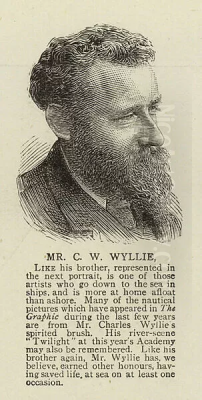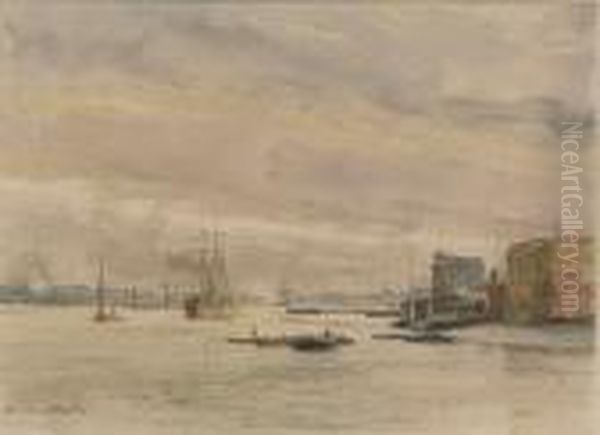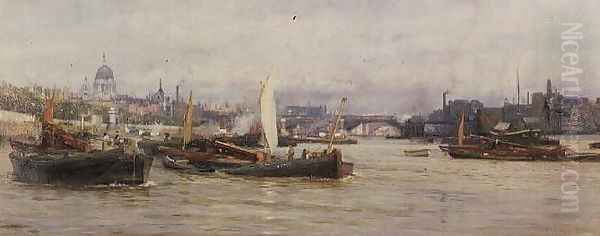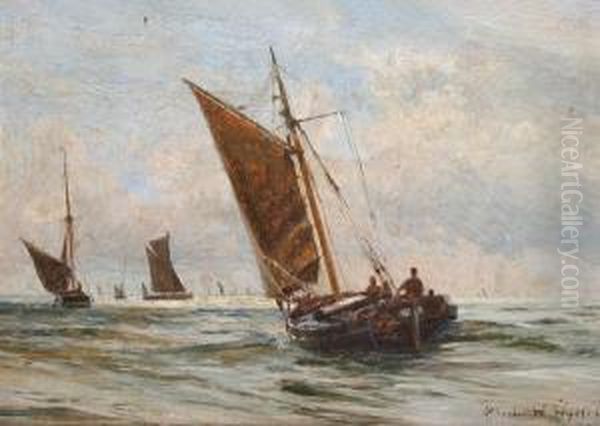
Charles William Wyllie (1853-1923) stands as a significant, if sometimes overshadowed, figure in the landscape of British art, particularly noted for his evocative depictions of coastal and riverine life. Born in London into a family already steeped in artistic pursuits, his career unfolded during a dynamic period of Victorian and Edwardian Britain, an era marked by industrial change, maritime prowess, and a flourishing of diverse artistic styles. Wyllie carved a niche for himself with his sensitive portrayals of the Thames, the English and French coasts, and the human activities that animated these environments.
Early Life and Artistic Genesis
Charles William Wyllie was born in London on June 18, 1853. He was the younger son of William Morrison Wyllie (1820-1895), a painter of genre and historical subjects, and Katherine Benham (1813-1872), a singer. This artistic milieu undoubtedly shaped his early inclinations. His elder brother, William Lionel Wyllie (1851-1931), would go on to become one of Britain's most celebrated marine painters, a Royal Academician whose works captured the grandeur and dynamism of the Royal Navy and maritime commerce. The Wyllie family also included a half-brother, Lionel Percy Smythe (1839-1918), son of Katherine Benham from a previous marriage, who also achieved distinction as a painter of rural and coastal scenes, becoming a member of both the Royal Academy and the Royal Watercolour Society.
The Wyllie family maintained homes in both England and France, traditionally spending summers on the French coast, particularly around Wimereux and Boulogne, and winters in England. This cross-channel upbringing exposed Charles to diverse landscapes and cultural influences from a young age. Like his brother William, Charles did not initially receive a formal school education; their mother taught them reading, writing, and music. Both brothers developed a profound love for the sea and became excellent swimmers, a skill that would serve them well in their shared passion for boating and observing marine environments firsthand.

Charles's artistic talents were evident early on. He, along with William, was encouraged by their father. He later pursued formal art training, first at Leigh's School of Art (later Heatherley's School of Fine Art), a notable institution that also saw students like Frederic Leighton and Edward Burne-Jones pass through its doors. Following this, Charles enrolled in the prestigious Royal Academy Schools, further honing his skills in drawing and painting. It was here that he would have been immersed in the academic traditions, while also being exposed to the burgeoning new movements in art.
The Lure of the Water: Thames and Coastal Scenes
From the outset of his exhibiting career, Charles William Wyllie demonstrated a particular affinity for landscapes and marine subjects, though his early focus was perhaps more on the coastal landscape and its inhabitants than the open sea drama often favored by his brother. He began exhibiting at the Royal Academy in 1872, with a work titled "A Wreck on the Goodwins," signaling his early interest in maritime themes.
The River Thames became a central and recurring subject in Charles Wyllie's oeuvre. He painted numerous scenes along its banks, capturing its varied moods and the bustling activity it supported. Works such as "Lower Thames" and "The Crossing Point" exemplify his ability to convey the atmosphere of the river, from its industrial heartlands to its more tranquil stretches. He was adept at depicting the interplay of light on water, the movement of barges and ships, and the architectural features that lined the riverbanks. His paintings often documented the industrial age Thames, with smoking chimneys, busy wharves, and the constant traffic of commerce, providing a valuable visual record of London's lifeblood.
One of his most acclaimed early works was "Digging for Bait," exhibited at the Royal Academy in 1877. This painting, depicting figures on a beach engaged in the titular activity, was purchased for the nation under the terms of the Chantrey Bequest, a significant honor for a young artist. The work showcased his skill in figure painting and his ability to capture the everyday life of coastal communities with a sense of quiet dignity, a quality shared by some of the French Realist painters like Jules Bastien-Lepage, whose influence was beginning to be felt in Britain.
His connection to the French coast, cultivated since childhood, also provided rich subject matter. He painted scenes in Normandy and Brittany, capturing the distinct light and character of these regions. These works often featured fisherfolk, beaches, and harbors, rendered with a sensitivity that reflected his deep familiarity with the locales.
Artistic Style, Techniques, and Affiliations

Charles William Wyllie worked proficiently in oil, watercolour, and etching. His style, while rooted in Victorian realism, often displayed a lyrical quality and a keen sensitivity to atmospheric effects. His brushwork could be both detailed and fluid, adapting to the subject at hand. In his Thames scenes, for instance, he masterfully rendered the hazy light of London or the reflective sheen of the water under different weather conditions. His compositions were carefully constructed, often leading the viewer's eye through the scene with a strong sense of perspective.
While his brother William Lionel Wyllie became renowned for his dramatic portrayals of naval power and vast seascapes, often with an almost photographic accuracy in nautical detail, Charles's work, particularly his coastal scenes, frequently incorporated a stronger narrative or genre element, focusing on the human presence within the landscape. His figures, whether toiling on the shore or navigating a small boat, are integral to the scene, imbuing it with a sense of lived experience.
Charles Wyllie was an active participant in the London art world. He exhibited regularly at the Royal Academy for many years, as well as at other prestigious venues such as the Royal Society of British Artists (RBA), of which he became a member, and the Royal Institute of Oil Painters (ROI), where he also held membership. He also showed his work at the Grosvenor Gallery, a more progressive alternative to the Royal Academy, known for showcasing Aesthetic Movement artists like James McNeill Whistler and Edward Burne-Jones. His participation in these varied venues indicates a broad acceptance and recognition of his talent across different segments of the art establishment.
His etchings, like those of his brother, demonstrated a fine command of line and tone, often translating the atmospheric qualities of his paintings into the print medium. These prints helped to disseminate his imagery to a wider audience.
Notable Works and Thematic Concerns
Beyond "Digging for Bait," several other works highlight Charles Wyllie's thematic concerns and artistic strengths. "The River Closed by Ice" is a powerful depiction of the Thames in winter, showcasing his ability to capture the stark beauty and altered character of the familiar river landscape under extreme conditions. Such scenes of urban or industrial landscapes under snow were also explored by contemporaries like Atkinson Grimshaw, though Wyllie's approach was typically less focused on nocturnal or moonlit effects.

His painting "Home with the Tide" (exhibited RA 1880) is another example of his coastal genre scenes, likely depicting a fishing boat returning to harbor, a theme popular with artists of the Newlyn School in Cornwall, such as Stanhope Forbes and Frank Bramley, who also focused on the lives of fishing communities. While Wyllie was not formally part of the Newlyn School, his interest in similar subject matter reflects a broader Victorian fascination with coastal life and labor.
"The Brimming River" (exhibited RA 1884) and "The End of the Day" (exhibited RA 1891) further illustrate his continued engagement with riverine and coastal themes, emphasizing atmosphere and the human element. His works often convey a sense of tranquility or quiet industry, rather than high drama. Even in a subject like "A Wreck on the Goodwins," the focus is likely to have been on the aftermath and the human response rather than the cataclysm itself, distinguishing his approach from the more turbulent sea pieces of J.M.W. Turner, whose legacy loomed large over British marine painting.
During World War I, like many artists, Charles Wyllie contributed to the war effort. While his brother W.L. Wyllie became an official war artist for the Royal Navy and was involved in developing dazzle camouflage alongside artists like Norman Wilkinson, Charles's specific contributions are less documented but it is known he also engaged in work related to naval camouflage. This period may have seen his art take on a more documentary or patriotic tone, reflecting the national crisis.
The Wyllie Artistic Dynasty and Contemporaries
The Wyllie family was a veritable artistic dynasty. Charles's career developed alongside that of his immensely successful brother, William Lionel Wyllie. While they shared a passion for marine subjects, their styles and focuses diverged enough for each to establish his own reputation. W.L. Wyllie's fame as a depictor of grand naval occasions and his meticulous accuracy in ship portraiture perhaps overshadowed Charles's quieter, more landscape-oriented contributions in the public eye, but Charles maintained a consistent and respected career.
Their father, William Morrison Wyllie, and half-brother, Lionel Percy Smythe, further enriched this artistic environment. Smythe, in particular, gained considerable acclaim for his idyllic rural scenes and coastal paintings, often with a touch of French Impressionist influence in his handling of light and colour, an influence that can also be subtly discerned in some of Charles Wyllie's later works.
Charles Wyllie worked during a period of great artistic ferment. The Pre-Raphaelite Brotherhood had made its impact, and artists like John Brett were producing highly detailed coastal scenes. The Aesthetic Movement, championed by Whistler, emphasized "art for art's sake," and Whistler's own Thames nocturnes offered a radically different vision of the river. The rise of French Impressionism, with artists like Claude Monet and Camille Pissarro (who both spent time in London), began to influence British painters, leading to movements like British Impressionism. While Charles Wyllie remained largely within a broadly realist tradition, his sensitivity to light and atmosphere suggests an awareness of these evolving artistic currents.
Other marine painters of the era included figures like Henry Moore (the 19th-century marine painter, not the sculptor), Thomas Somerscales, and later, Montague Dawson, each contributing to the rich tradition of British sea painting. Wyllie's focus on the Thames also places him in a lineage that includes earlier masters like Canaletto and Samuel Scott, who famously depicted the river in the 18th century.
Exhibitions, Collections, and Market Reception
Charles William Wyllie was a prolific exhibitor. Records show he exhibited at least 77 works at the Royal Academy, 41 at the Royal Society of British Artists, 16 at the Royal Institute of Oil Painters, and numerous works at other galleries in London and provincial cities. His work was also shown internationally, including at the Paris Salon.
His paintings found their way into important public and private collections. As mentioned, "Digging for Bait" is in the Tate collection (via the Chantrey Bequest). Other institutions holding his work include the National Maritime Museum in Greenwich, which also has a significant collection of his brother's art, the British Museum (likely prints), and various regional galleries such as the Dudley Museum and Art Gallery. The presence of his work in these collections underscores his contemporary recognition and historical importance.
In terms of market reception, Charles William Wyllie's works appear regularly at auction. Prices can vary significantly based on size, subject matter, condition, and provenance. His oil paintings of Thames views or significant coastal scenes generally command higher prices than smaller watercolours or etchings. For example, a work like "The Thames at Gravesend" (1913) might be estimated in the range of £500-£800 or more, depending on its quality and size, in regional auctions. Some larger or more significant pieces have achieved higher figures. His etchings, such as "St Andrew's Harbour - Bringing in the Catch," are more accessible, often appearing with estimates of £100-£150. While perhaps not reaching the top-tier prices of his more famous brother or some of the leading Impressionists, his work remains consistently collectible and appreciated for its artistic merit and historical value.
Legacy and Conclusion
Charles William Wyllie passed away on 28 July 1923 in St John's Wood, London. He left behind a substantial body of work that captures the essence of British coastal and riverine life during the late Victorian and Edwardian eras. His paintings serve not only as beautiful artistic creations but also as valuable historical documents, recording the changing face of the Thames, the enduring traditions of coastal communities, and the maritime spirit of his time.
While often mentioned in the context of his more famous brother, Charles William Wyllie was an accomplished artist in his own right, with a distinct voice and vision. His dedication to his chosen subjects, his skillful technique, and his ability to evoke atmosphere and human presence ensure his place in the annals of British art. He contributed significantly to the tradition of landscape and marine painting, offering a perspective that was both observant and deeply felt. His works continue to be admired for their quiet beauty, their honest depiction of everyday life, and their celebration of the enduring relationship between people and the water. As a member of the remarkable Wyllie artistic family, he played his part in enriching Britain's visual heritage, leaving a legacy that continues to resonate with those who appreciate the subtle art of capturing light, water, and life.